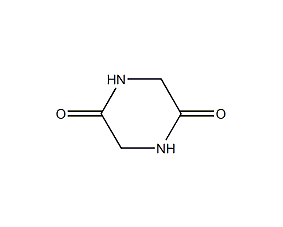
Structural formula
| Business number | 02TT |
|---|---|
| Molecular formula | C4H6N2O2 |
| Molecular weight | 114.10 |
| label |
2,5-piperazinedione, Glycine anhydride, Anhydrous glycidyl amino acid diazacyclodione, 2,5-diketopiperazine, 2,5-Dioxypiperazine, p-diazacyclodione, diketopiperazine, Anhydrous glycine, Piperazine-2,5-dione, 2,5-Dioxopiperazin, 2,5-Dioxopiperazine lactam, 2,5-Piperazindion, alpha,gamma-Diacipiperazine, Cyclic(glycylglycyl), Cyclo(glycylglycyl), Cyclodiglycine |
Numbering system
CAS number:106-57-0
MDL number:MFCD00006009
EINECS number:203-411-5
RTECS number:TL6325250
BRN number:112112
PubChem ID:None
Physical property data
1. Character: flake or needle crystal.
2. Density (g/mL, 25℃): Undetermined
3. Relative vapor density (g/mL, air=1): Undetermined
4. Melting point (ºC): 311-312 (decomposition)
5. Boiling point (ºC, normal pressure): Undetermined
6. Boiling point (ºC, kPa): Undetermined
7. Refractive index (D20): Undetermined
8. Flash point (ºC): Undetermined Determined
9. Specific rotation (ºC): Not determined
10. Autoignition point or ignition temperature (ºC): Not determined
11. Vapor Pressure (mmHg, 25ºC): Undetermined
12. Saturated vapor pressure (kPa, 25ºC): Undetermined
13. Heat of combustion (KJ/mol): Undetermined
p>
14. Critical temperature (ºC): Undetermined
15. Critical pressure (KPa): Undetermined
16. Oil-water (octanol/water) partition coefficient Logarithmic value of p>
19. Solubility: soluble in hot water, weakly alkaline.
Toxicological data
1. Acute toxicity: mouse intraperitoneal LD: >500mg/kg;
Ecological data
This substance is toxic to waterSlight harm.
Molecular structure data
1. Molar refractive index: 25.40
2. Molar volume (cm3/mol): 91.5
3. Isotonic specific volume (90.2K ): 227.3
4. Surface tension (dyne/cm): 38.1
5. Dielectric constant:
6. Dipole moment (10-24cm3):
7. Polarizability: 10.07
Compute chemical data
1. Reference value for hydrophobic parameter calculation (XlogP): -1.3
2. Number of hydrogen bond donors: 2
3. Number of hydrogen bond acceptors: 2
p>
4. Number of rotatable chemical bonds: 0
5. Number of tautomers: 6
6. Topological molecule polar surface area 58.2
7. Number of heavy atoms: 8
8. Surface charge: 0
9. Complexity: 116
10. Number of isotope atoms: 0
11. Determine the number of atomic stereocenters: 0
12. Uncertain number of atomic stereocenters: 0
13. Determine the number of chemical bond stereocenters: 0
14. Number of uncertain chemical bond stereocenters: 0
15. Number of covalent bond units: 1
Properties and stability
Avoid contact with strong oxidizing agents.
Storage method
Stored in a cool, ventilated warehouse. Keep away from fire and heat sources. Protect from direct sunlight. The packaging is sealed. should be kept away from oxidizer, do not store together. Equipped with the appropriate variety and quantity of fire equipment. Suitable materials should be available in the storage area to contain spills.
Synthesis method
Originated from the condensation of glycine. Mix glycine and ethylenediamine at a ratio of 1:5, stir and heat, react at 174-176°C for 50 minutes, then place in an icehouse to confirm, filter out the crystals, wash with methanol, and dry to obtain glycyl anhydride. It can also be prepared by condensing glycine in dehydrated glycerol.
Purpose
Used as biochemical reagents. Glycylglycine can be obtained by hydrolysis with alkali, acid or hot water.


